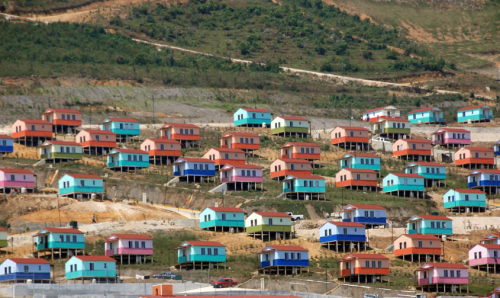On-going rural-urban migration has led to a proliferation of metropolitan areas and the construction of millions of new homes across Mexico. Thirty years ago, there were only 15 recognized metropolitan areas in Mexico, today there are 59.
In recent decades, there has been insufficient coordination between the various government departments responsible for housing, services and land development, such that some settlements were authorized even though they lacked or had inadequate access to highways or basic services. In many instances, settlements were given the green light even though the ownership of the land was still in dispute.
A recent Mexico City news report entitled Desorden urbano dejó en el país millones de viviendas fantasmas claims that this poor planning in Mexico has resulted in as many as 4 million houses, many of them newly built, standing empty.
Among the settlements with a large number of uninhabited new homes is Santiago el Pinar in the heart of the southern state of Chiapas, home of the indigenous coffee–growing Tzotzil Indians who have traditionally lived in dispersed rural communities where access to central services is difficult. The previous federal administration built hundreds of homes here in its effort to “develop” the area into a “sustainable rural city” (whatever that means!). It was hoped that modern homes, located near services such a small, new hospital, would help give the Tzotzil a chance to escape poverty, though it did involve some relocation.
This BBC clip – Santiago el Pinar: One Square Mile of Mexico – describes the plan and some of the obstacles it has encountered.
The people’s traditional dwellings have dirt floors where food can be cooked over small fires. The new homes, designed by Marco Antonio Constantino, are mounted on stilts and have wooden floors, where traditional forms of indoor cooking would be hazardous. There were also some serious issues of construction quality, as well as a significant delay in supplying water to the new homes. All these factors combined have meant that almost all of the new homes have quickly been abandoned.
The lack of provision of basic services (water, electricity, drainage) is also cited as a factor why many new homes elsewhere in Mexico remain unoccupied.
In the past 20-30 years, Mexico’s largest homebuilders (companies such as Urbi, Geo and Homex) have done very well financially. They are now having to adjust to tougher times. Part of their problem, according to the Mexican financial press, is that government policy has shifted away from the construction of single-family units (such as those in Santiago de Pinar), which these big companies thrived on, towards building multi-family vertical units. The advantages of the latter are they reduce overall energy usage and the total cost associated with supplying other essential services.
This brief look at the issue of empty houses in Mexico suggests that while Mexico is certainly changing, and often for the better, change (as evidenced by Santiago de Pinar) is not necessarily synonymous with progress.
Want to read more?
Related posts:
- Uxpanapa, an example of forced migration
- Resistance to government-sponsored change in Chiapas, Mexico
- The settlement patterns of the Tarahumara in Mexico’s Copper Canyon region
- The four basic types of rural locality in Mexico

Sorry, the comment form is closed at this time.